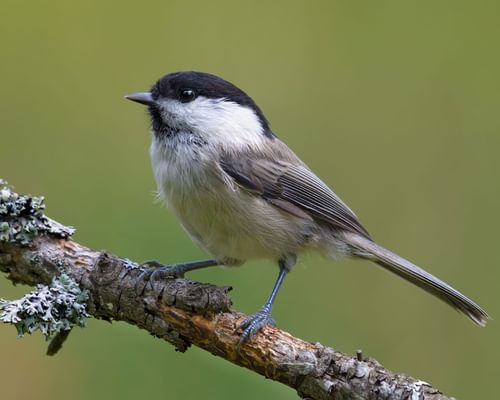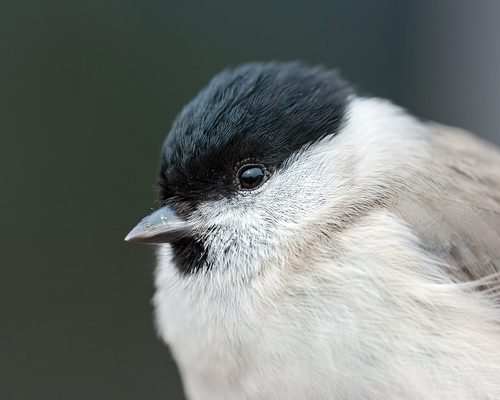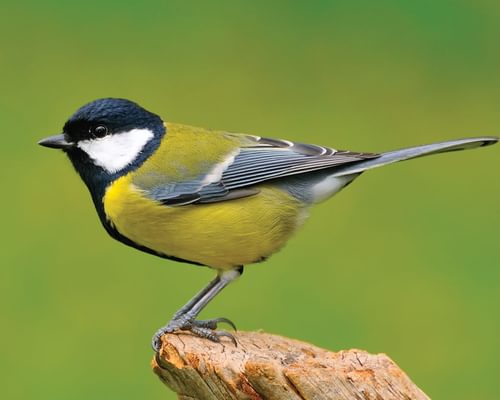Coal Tit
Periparus ater
Visual Identification
Appearance
The Coal Tit is a small bird, characterised by its black cap, white nape patch, and distinctive white cheek patches. Its upperparts are bluish-grey, while the underparts are buff to pale grey, creating a subtle contrast.
Both sexes look alike, with juveniles closely resembling adults but with slightly duller plumage.
Size
Length
10cm to 11.5cm
Wingspan
17cm to 21cm
Weight
8g to 10g
Colours
Males and females have similar plumage
Primary Colour
Black Grey
Secondary Colour
White Buff
Beak Colour
Black
Leg Colour
Blue-grey
Habitat and Distribution
Habitats
Woodland
Garden
Wetland
Coastal
Urban
Farmland
Grassland
Desert
Tundra
Rainforest
Mountain
Savanna
Distribution
Coal Tits are widely distributed across Europe and Asia, with a strong preference for coniferous and mixed woodlands. They are particularly abundant in areas with spruce, pine, and fir trees, providing food and nesting sites.
In the UK, Coal Tits are resident year-round and can be found in suitable habitats throughout the country, including gardens adjacent to woodlands. Their range extends from lowland to mountainous regions, adapting to various forest types.
Elevation Range
Up to 4,500 meters
Climate zones
Temperate, Subarctic
Distribution Map
This map gives you a rough idea of where you might spot a Coal Tit. The coloured areas show countries where these birds have been seen.
A few things to keep in mind:
- Birds might not be everywhere in the coloured areas, for example, they may be present around the coast of that country
- Where birds live can change with seasons and available food
- This map is quite simple - it doesn't show exact locations
We're working on making our maps even better! Soon, we hope to show you:
- More detailed maps for bigger countries, including state and region
- How birds move around during different seasons
Distribution by Region
Behaviour and Ecology
Bird Attributes
This feature is in beta. We'd love your feedback to improve it!
Share your thoughtsBird Attributes Explained
Our bird attributes system rates various aspects of a bird's capabilities on a scale of 0-100, based on data from field observations, scientific studies, and expert knowledge.
Attribute Categories:
- Agility: Manoeuvrability, speed, and grace in flight or movement.
- Strength: Physical power, often correlating with size and hunting abilities.
- Adaptability: Ability to thrive in various environments or changing conditions.
- Aggressiveness: Territorial behaviour and assertiveness, particularly during breeding seasons.
- Endurance: Stamina, often seen in migration patterns or foraging behaviours.
Understanding the Ratings:
- 0-20: Very Low
- 21-40: Low
- 41-60: Average
- 61-80: High
- 81-100: Very High
Remember, these attributes are relative to other bird species and don't necessarily indicate superiority.
Hover over the icon next to each attribute for more information.
Tap the icon next to each attribute for more information.
Agility
Reflects the bird's manoeuvrability, speed, and grace in flight or movement.
The Coal Tit is exceptionally agile, renowned for its acrobatic ability to hang upside down whilst foraging. Its rapid movements through coniferous forests and quick darting at bird feeders demonstrate remarkable agility for its size.
Strength
Indicates the bird's physical power, often correlating with size and hunting abilities.
As a tiny bird weighing only 8-10 grams, the Coal Tit's strength is limited. However, it possesses enough strength to manipulate seeds and small insects, and to excavate nesting sites in soft wood or earth.
Adaptability
Represents the bird's ability to thrive in various environments or changing conditions.
Coal Tits show high adaptability, thriving in various woodland habitats from sea level to 4,500 metres elevation. Their ability to cache food, join mixed-species flocks, and even imitate other birds' calls indicates significant adaptive capabilities.
Aggressiveness
Measures the bird's territorial behaviour and assertiveness, particularly during breeding seasons.
While not particularly aggressive, Coal Tits can be assertive in defending their territory and food caches. They produce chattering sounds during disputes, but overall, their social nature and tendency to flock with other species suggest low aggression.
Endurance
Reflects the bird's stamina, often seen in migration patterns or foraging behaviours.
Despite their small size, Coal Tits demonstrate considerable endurance. Their ability to survive harsh winters, forage continuously, and cache up to 800 food items daily indicates robust stamina. However, their short lifespan of 2-3 years suggests some limitations to their overall endurance.
Diet
Coal Tits primarily feed on small insects, spiders, and seeds. Their diet shifts seasonally, with a greater emphasis on insects during the breeding season and more seeds in winter.
They are excellent at extracting seeds from conifer cones and are frequent visitors to bird feeders.
Behaviour
Coal Tits are remarkably agile, often seen hanging upside down from branches while foraging. They are known for their 'hoarding' behaviour, storing seeds in bark crevices for later consumption.
They are highly social and frequently join mixed-species flocks outside the breeding season, enhancing their foraging efficiency and predator awareness.
Vocalisation
The Coal Tit's call is a high-pitched, thin 'tsee-tsee-tsee' or 'pitchou', often repeated rapidly. Their song is a simple but melodious trill, typically described as 'tee-chu-chu-chu'.
During territorial disputes, they produce a distinctive rapid chattering sound.
Nesting & Breeding
Coal Tits typically form monogamous pairs during the breeding season, which begins in late April or early May. Males court females with a combination of song and displays, often offering food as part of the courtship ritual.
Nests are usually built in tree holes, crevices, or ground, lined with moss, hair, and feathers. The female lays 7-11 small white eggs with reddish-brown speckles.
Incubation lasts about 14-16 days, and it is primarily performed by the female. Both parents feed the nestlings, which fledge after 16-19 days but continue to receive parental care for several weeks after that.
Conservation and Status
Global Conservation Status
While currently listed as Least Concern, Coal Tits face challenges from habitat loss due to deforestation and climate change.
Conservation efforts focus on maintaining diverse forest habitats and promoting sustainable forestry practices to ensure the species' long-term survival.
Birdwatching Tips
- Look for Coal Tits in coniferous forests and mixed woodlands
- Listen for their distinctive 'pitchou' call, which is higher-pitched than other tit species
- Observe bird feeders, where they often dart in quickly to grab seeds
- In the UK, watch for them in gardens, especially those near wooded areas
Additional Information
Quick Facts
Predators
Did You Know?
- Coal Tits have been observed imitating the calls of other bird species, possibly as a defence mechanism.
- They can store up to 800 food items daily, remembering numerous cache locations.
- Coal Tits have a special adaptation that allows them to hold food under their tongue while foraging.
FAQs
Distinguishing between Coal Tit, Willow Tit and Marsh Tit
In appearance, you are more likely to have difficulty distinguishing the Willow Tit and the Marsh Tit from the coal tit than other tits found within the UK.
This is mainly due to their size and overall colour, which is smaller and duller than Blue Tits or Great Tits. Neither the marsh nor the willow tit has wing bars, whereas the coal tit has two and the blue tit and great tit only one.
The coal tit is also the only one to have a distinctive white patch on its nape. They will often nest almost at ground level in old tree stumps and are the smallest tit resident on our shores.
Similar Birds
References
- 1 2
website: BirdLife International. 2017. Periparus ater (amended version of 2016 assessment). The IUCN Red List of Threatened Species 2017: e.T22735965A118835425.
View source - 3
report, 2015: EBCC
- 4
journalArticle, 2006: Moller, Sociality, age at first reproduction and senescence: comparative analyses of birds, J Evol Biol, 19:682-689
View source
Share Your Feedback
We value your opinion! Let us know what you think about this bird page.


